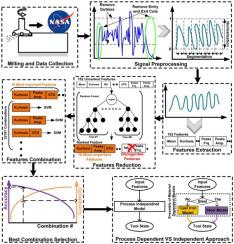CIRP Journal of Manufacturing Science and Technology ( IF 4.8 ) Pub Date : 2020-12-25 , DOI: 10.1016/j.cirpj.2020.12.002 Mohamed Abubakr , Muhammed A. Hassan , Grzegorz M. Krolczyk , Navneet Khanna , Hussien Hegab

|
Tool failure detection is a crucial task for continuous safe machining operations. In this study, a novel approach is proposed to develop an accurate and simple tool condition classification model (TCCM) for early failure detection during machining processes. Signals from current, vibration, and acoustic emission sensors were preprocessed and used for feature extraction in both time and frequency domains, leading to a total of 152 features. Next, a feature reduction was carried out based on relative importance, computed using a fully-grown random forest, which reduced the number of features to 15. To find out the best combination of relevant signal features, a total of 32,767 optimized support vector classifiers were developed. The comparison between different candidate models was based on both accuracy and complexity. The results showed that a classification accuracy up to 0.911 is attainable for a process-independent classification model using only current sensors. Besides, developing an ensemble of material-dependent models showed a good potential for improvement, recording a classification accuracy up to 0.958 while using features extracted only from the current sensors. The novelty in the present study is in its focus on developing a single sensor-based high-accuracy TCCM. This opens the door for wider utilization of such technology, especially that all existing studies focused on increasing the accuracy using multi-sensor TCCMs, which increases the cost of this technology and makes it inaccessible, especially for small and medium enterprises.
中文翻译:

用于加工过程中刀具故障检测的传感器选择:一个简单而准确的分类模型
刀具故障检测是连续安全加工操作的关键任务。在这项研究中,提出了一种新颖的方法来开发一种准确,简单的刀具状态分类模型(TCCM),以便在加工过程中进行早期故障检测。对来自电流,振动和声发射传感器的信号进行了预处理,并用于时域和频域中的特征提取,总共产生了152个特征。接下来,基于相对重要性进行了特征缩减,并使用完全生长的随机森林进行了计算,将特征数量减少至15。要找出相关信号特征的最佳组合,总共需要32,767个优化支持向量分类器被开发。不同候选模型之间的比较是基于准确性和复杂性。结果表明,仅使用电流传感器的过程独立分类模型的分类精度可达到0.911。此外,开发一组依赖于材料的模型具有改进的潜力,在使用仅从当前传感器中提取的特征的情况下,记录分类精度高达0.958。本研究的新颖之处在于致力于开发基于单个传感器的高精度TCCM。这为更广泛地使用这种技术打开了大门,尤其是所有现有研究都集中在使用多传感器TCCM来提高准确性上,这增加了该技术的成本并使其难以获得,特别是对于中小型企业。对于仅使用电流传感器的与过程无关的分类模型,可以获得911。此外,开发一组依赖于材料的模型具有改进的潜力,在使用仅从当前传感器中提取的特征的情况下,记录分类精度高达0.958。本研究的新颖之处在于致力于开发基于单个传感器的高精度TCCM。这为更广泛地使用这种技术打开了大门,尤其是所有现有研究都集中在使用多传感器TCCM来提高准确性上,这增加了该技术的成本并使其难以获得,特别是对于中小型企业。对于仅使用电流传感器的与过程无关的分类模型,可以获得911。此外,开发一组依赖于材料的模型具有改进的潜力,在使用仅从当前传感器中提取的特征的情况下,记录分类精度高达0.958。本研究的新颖之处在于致力于开发基于单个传感器的高精度TCCM。这为更广泛地使用这种技术打开了大门,尤其是所有现有研究都集中在使用多传感器TCCM来提高准确性上,这增加了该技术的成本并使其难以获得,特别是对于中小型企业。958,而仅使用从当前传感器中提取的特征。本研究的新颖之处在于致力于开发基于单个传感器的高精度TCCM。这为更广泛地使用这种技术打开了大门,尤其是所有现有研究都集中在使用多传感器TCCM来提高准确性上,这增加了该技术的成本并使其难以获得,特别是对于中小型企业。958,而仅使用从当前传感器中提取的特征。本研究的新颖之处在于致力于开发基于单个传感器的高精度TCCM。这为更广泛地使用这种技术打开了大门,尤其是所有现有研究都集中在使用多传感器TCCM来提高准确性上,这增加了该技术的成本并使其难以获得,特别是对于中小型企业。



























 京公网安备 11010802027423号
京公网安备 11010802027423号